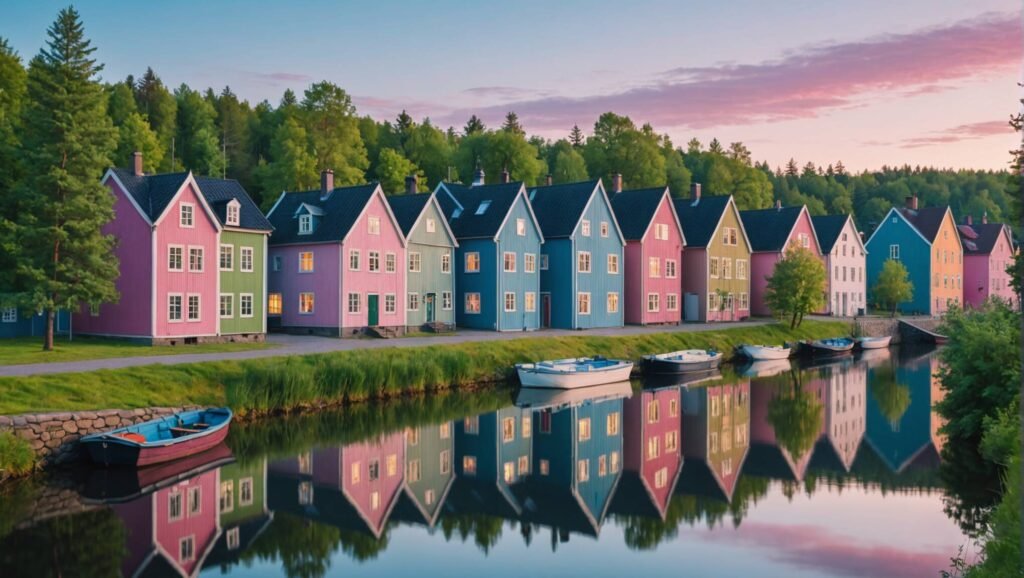Switzerland vs Sweden: 7 Key Differences (Travel Guide 2024)
When planning a European adventure, Switzerland vs Sweden often emerges as a compelling comparison. Both countries boast stunning landscapes, rich cultures, and high standards of living, yet they offer distinctly different experiences for travellers. This comprehensive guide will explore the seven key differences between these two captivating destinations, helping you make an informed decision for your next journey.
1. Geography and Landscapes
Switzerland and Sweden present starkly contrasting geographical features that shape their respective travel experiences.
Switzerland: Alpine Majesty
Switzerland is renowned for its dramatic Alpine scenery. The country’s landscape is dominated by towering mountains, pristine lakes, and picturesque valleys. The Swiss Alps cover about 60% of the country, offering world-class skiing, hiking, and mountaineering opportunities. Iconic peaks like the Matterhorn and Jungfrau draw adventure seekers from around the globe.
Sweden: Nordic Beauty
In contrast, Sweden’s landscape is characterised by vast forests, thousands of lakes, and an extensive coastline dotted with islands. While it does have mountains in the north, they are not as imposing as the Swiss Alps. Sweden’s natural beauty shines through its expansive wilderness areas, including the Arctic wonderland of Kiruna, offering unique experiences like the Northern Lights and midnight sun.
2. Climate and Seasons
The climate in Switzerland and Sweden varies significantly, influencing the best times to visit and the activities available.
Switzerland: Mild and Varied
Switzerland experiences a temperate climate with regional variations. Summers are generally warm and pleasant, while winters are cold, especially in the mountainous regions. The country offers year-round attractions, from summer hiking to winter skiing, making it a versatile destination.
Sweden: Distinct Seasonal Contrasts
Sweden’s climate is more extreme, with long, cold winters and short, mild summers. The northern parts of the country experience subarctic conditions, including the polar night in winter and the midnight sun in summer. This creates unique seasonal attractions, such as ice hotels in winter and endless daylight for outdoor activities in summer.
3. Cultural Heritage and Traditions
Both countries have rich cultural heritages, but they stem from different historical backgrounds.
Switzerland: Multicultural Fusion
Switzerland’s culture is a blend of German, French, and Italian influences, reflecting its position at the crossroads of Europe. This diversity is evident in its languages, cuisine, and traditions. Swiss culture is often associated with precision, neutrality, and a strong work ethic.
Sweden: Nordic Roots
Sweden’s culture is deeply rooted in Nordic traditions. It’s known for its egalitarian values, design aesthetics, and progressive social policies. Swedish customs like fika (coffee break) and Midsummer celebrations are integral to the national identity.
4. Urban Experiences
The cities in Switzerland and Sweden offer different urban experiences for travellers.
Switzerland: Charming and Historical
Swiss cities like Zurich, Geneva, and Lucerne are known for their well-preserved medieval old towns, world-class museums, and picturesque settings against mountain backdrops. These cities blend historical charm with modern efficiency.
Sweden: Modern and Trendsetting
Swedish cities, particularly Stockholm and Gothenburg, are celebrated for their modern design, innovative culture, and commitment to sustainability. They offer a perfect blend of historical sites and cutting-edge urban experiences.
5. Outdoor Activities and Nature Experiences
Both countries excel in offering outdoor adventures, but with different focuses.
Switzerland: Alpine Adventures
Switzerland is a paradise for mountain enthusiasts. It offers world-class skiing, snowboarding, hiking, and mountaineering. The country’s efficient mountain transport systems make these activities highly accessible.
Sweden: Wilderness Exploration
Sweden’s outdoor experiences centre around its vast wilderness. Activities include hiking through national parks, kayaking in archipelagos, and Arctic adventures in Kiruna. The country’s ‘Right of Public Access’ law allows extensive freedom to roam and camp in nature.
6. Culinary Traditions
The culinary landscapes of Switzerland and Sweden offer distinct gastronomic experiences.
Switzerland: Gourmet Delights
Swiss cuisine is famous for its cheese and chocolate. Fondue, raclette, and rösti are iconic dishes. The country also boasts numerous Michelin-starred restaurants, reflecting its gourmet culture.
Sweden: Nordic Cuisine Revolution
Swedish cuisine has gained international recognition for its focus on fresh, local ingredients and innovative cooking techniques. Traditional dishes like meatballs and gravlax coexist with the New Nordic Cuisine movement, offering a unique culinary experience.
7. Travel Costs and Accessibility
Budget considerations and ease of travel differ between the two countries.
Switzerland: Premium Experience
Switzerland is known for its high cost of living and travel expenses. However, this is often balanced by the exceptional quality of services and experiences. The country’s compact size and efficient public transport system make it easy to explore multiple destinations in a short time.
Sweden: Varied Options
While not cheap, Sweden generally offers more budget-friendly options compared to Switzerland. The country’s larger size means more diverse travel experiences but potentially longer travel times between destinations. Sweden’s well-developed public transport system and extensive flight network make navigation straightforward.
In conclusion, choosing between Switzerland and Sweden depends on your travel preferences. Switzerland offers Alpine adventures and a central European flair, while Sweden provides Nordic charm and vast wilderness experiences. Both countries promise unforgettable journeys, each with its unique appeal.
FAQ
Which country is better for winter sports, Switzerland or Sweden?
Switzerland is generally considered superior for winter sports, particularly skiing and snowboarding, due to its extensive Alpine regions and world-renowned ski resorts. However, Sweden offers unique winter experiences like dog sledding and ice fishing, especially in its northern regions.
Is English widely spoken in both Switzerland and Sweden?
English is widely spoken in both countries, especially in tourist areas and among younger generations. However, Sweden generally has a higher proficiency in English, with most Swedes being fluent. In Switzerland, English proficiency can vary depending on the region.
Which country is more budget-friendly for travellers?
Generally, Sweden is considered more budget-friendly than Switzerland. While both countries are relatively expensive by European standards, Switzerland’s prices for accommodation, food, and activities tend to be higher. Sweden offers a wider range of budget options, especially outside major cities.

